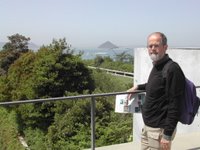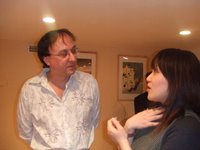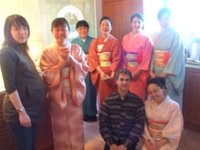2006 June: Hans Blokpoel "Simply Sculpture"

 Simply Sculpture
Simply SculptureAbstract works in stone
by Hans Blokpoel
In the Stepping Stones Art Gallery
June 3 – 4, 2006
Bio
Hans Blokpoel was born and educated in the Netherlands before emigrating to Canada in 1967. He has taken courses in sculpture both in Holland (with a local sculptor in Leiden) and in Canada (at the Ottawa School of Art). Currently a retired wildlife biologist, he has had a life-long interest in the beauty that is present in nature. His works are usually fairly stylized or abstract and they occasionally contemplate the human condition.
Artist Exhibit Statement
During a 4-week trip to Japan in 2002 (Kyoto, Takamatsu, Shodoshima and Benesse Islands) I was struck by the seemingly simple use of materials and the veneration for old works of art. I felt an affinity with those works and I am still inspired by them.
The large public sculptures, from stone from local quarries on Shodoshima Island, were also inspirational.
In my works designed for patios and gardens I try to make works that add visual pleasure to the garden. I like to use biomorphic objects that complement the natural shapes and forms of garden plants.
I have always been fascinated by the virtually unlimited numbers of shapes, forms, patterns, textures and materials that are present in nature.
My works are highly abstract and they often provide a surprising presence that animates the area around them.
The garden works are designed to stay outside during the winter and thus provide visual interest year-round. The works are given special effects by hoarfrost, freezing rain and snow. My smaller sculptures are more suitable for homes or offices.
I have been making a number of different "lines of work" and for this show I exhibit some works of these different lines of work.
Works using old bricks
I use eroded bricks and chunks of concrete to design simple, free-standing sculptures that are relatively small.
I also use eroded bricks to create totemic contemplation poles.
The Fragmentation Series
Another source of inspiration and material has been natural rocks that had fragmented or that were in the process of disintegrating.
I encountered these rocks in the Ottawa area and I have tried to "freeze" their fragmentation by emphasizing the fracture faces with colour.
Aerial Landscapes on Slate
More recently, I have been using square tiles of multi-colour slate to make imaginary landscapes that are designed to be hung on walls, but that can be displayed on horizontal surfaces as well.
I use slate tiles as metaphors for landscapes, as seen from the air, and small artifacts as metaphors for human impacts
in the landscape.
The landscapes are glimpses from an aircraft window. They are imaginary and do not attempt to depict real landscapes. They are neither models nor to scale. Even so, the landscapes are inspired by my own observations from aircraft as well as by air photographs taken by others.
Slate is a fine-grained rock that has been used to make roof tiles and school boards because it splits into thin, smooth-surfaced layers.
The tiles of multi-colour slate I used for this show have a mysterious feeling because they contain unknown geological history.
I selected tiles that “spoke” to me because they suggested landscapes (as seen from the air), or just because they were beautiful or otherwise interesting.
To indicate the human impact on the landscape I used man-made materials, such as various bits of hardware. I like to reuse discarded materials that have their own history to tell.
I am also interested in labyrinths and stone circles that can be found as sturdy and intriguing remains of the past. Here I use small pebbles that I collected from a local river to simulate the enormous monoliths that were used by our prehistoric forefathers to construct burial chambers and large sacred meeting places.
Solo exhibitions & invited Guest Sculptor
1993 - A resurrection of stones. Foyer Gallery, Nepean
1997 - Blokkedoos Gallery, Merrickville (guest sculptor)
2001 - Perceptions of Canada. Gamma Ray Gallery, Ottawa (guest sculptor)
2005 - Landscapes in slate, Atrium Gallery, Ben Franklin Place, Ottawa
Group exhibitions
1994 – 2005. The annual Dimensions Shows and other shows held by the National Capital Network of Sculptors.
Memberships
· The International Sculpture Center
· National Capital Network of Sculptors (2005 President)
Awards
“Mountain” at the Dimensions 2002 Show was the winner of the “NCNS Artists Choice Award”.
Contact Hans at: blokpoel[at]magma.ca
or visit www.magma.ca/~blokpoel



